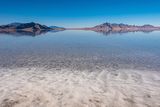Now Reading: Human Impact Drives Drastic Change in Great Salt Lake Over Two Centuries
-
01
Human Impact Drives Drastic Change in Great Salt Lake Over Two Centuries
Human Impact Drives Drastic Change in Great Salt Lake Over Two Centuries

Quick summary
- The Great Salt Lake, known as a barometer of environmental change, has undergone dramatic transformations over 200 years due to human activity.
- Researchers analyzed sediment cores to uncover changes spanning nearly 8,000 years, revealing disruptions from European settlers and infrastructure projects.
- Two major disruptions include:
– Mid-19th-century irrigation agriculture by Mormon settlers (1847), which increased organic matter and altered the lake’s carbon balance.
– Union Pacific railroad causeway construction (1959), which divided the lake’s arms and sharply shifted salinity levels.
- The study links today’s ecological crisis with historical human-driven impacts unseen in millennia.
Indian Opinion Analysis
This finding is an important reminder of humanity’s profound ability to reshape natural ecosystems even within relatively short periods of history-an implication that resonates globally amidst growing concerns about climate change and environmental degradation. For India, known for its own vulnerable water bodies such as the Ganga river basin or inland saline lakes like Sambhar Lake, this study underscores the need for enduring watershed management practices rooted in long-term observations.
The research demonstrates how incremental anthropogenic pressures can cumulatively result in irreversible ecological shifts over centuries-a lesson relevant for Indian policymakers aiming to balance growth with conservation efforts amid rapid population growth and industrial activities impacting water systems across the country.
























